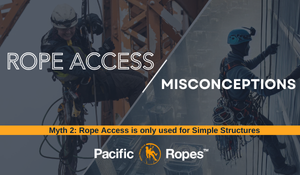Myth 2: It’s Only for Simple Structures
The Reality: Complex areas are only accessible by experienced technicians using ropes
Another common myth is that rope access is suitable only for basic structures, completing tasks like window cleaning or painting on high-rises. However, just because you don't see it doesn’t mean it doesn’t exist! Rope access is not only capable of handling complex structures—it is often the preferred method for them.
Fewer Constraints and More Accessibility
Traditional access methods such as scaffolding, boom lifts, and cranes require extensive setup, take up significant space, and are often impractical for structures with irregular geometries, confined spaces, or extreme heights. Rope access eliminates these constraints, allowing skilled technicians to navigate frameworks, reach obstructed areas, and work in locations where conventional methods simply cannot operate. 
Efficient Movement and Positioning
Using advanced rigging techniques, rope access technicians can move efficiently between multiple work locations without the need for repositioning heavy equipment. This is particularly advantageous for inspections, maintenance, and installations in areas with significant elevation changes, narrow passageways, or irregularly shaped surfaces. Whether it’s performing a corrosion survey inside a towering grain silo, inspecting the underside of a bridge, or installing heavy components within an elevator shaft, rope access provides unmatched flexibility.

Minimal Disruptions
Beyond accessibility, rope access also minimizes disruption to operations. Unlike scaffolding, which can obstruct workflow for weeks, or lifts that require ground-level clearance, rope access allows technicians to work with minimal interference, making it ideal for waterparks, commercial facilities, and industrial plants where downtime is costly. Additionally, with strict safety standards and redundant systems in place, rope access has an outstanding safety record, ensuring that even the most complex tasks are performed securely and efficiently.

Ultimately, when it comes to intricate structures and challenging access scenarios, rope access isn’t just an option—it’s the smartest choice.

The Reality Check:
Rope access is not just for simple structures—it’s often the best solution for complex ones. Traditional methods like scaffolding and lifts can be costly, take up space, and don’t always work for irregular or hard-to-reach areas.
With rope access, technicians can move efficiently between work locations without heavy equipment or setup delays. This makes it ideal for industrial plants, bridges, confined spaces, and other challenging environments. It also reduces downtime, allowing work to be completed with minimal disruption.
When access is difficult, rope access is often the safest, most efficient, and most practical choice.
Wondering how you can utilize rope access work on site, whether you're a manager, contractor, or client? Don't hesitate and book a meeting with us!




